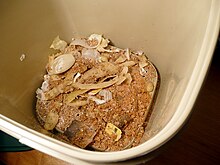Horticulture/Bokashi
<Horticulture/Soils and Composts

Bokashi means "fermented matter" and is a method that uses a mix of microorganisms to cover food waste to decrease smell. It is an anaerobic -- lacking oxygen -- fermentation process that breaks down matter in about four to six weeks.
It derives from the practice of Japanese farmers centuries ago of covering food waste with rich, local soil that contained the microorganisms that would ferment the waste. After a few weeks, they would bury the waste. Some weeks later it would become soil.[1]. So, Bokashi is a two-step method: collecting food in an oxygen free setting, usually inside, and then letting nature decompose the rest outside, underground
Most practitioners obtain the microorganisms from the product Effective Microorganisms (EM1),[1] first sold in the 1980s. EM1 is mixed with a carbon base (e.g. sawdust or wheat or rice bran) that it sticks to and a sugar for food (e.g. molasses). The mixture is layered with waste in a sealed container and after a few weeks, removed and buried.[1]
Newspaper fermented in a lactobacillus culture can be substituted for bokashi bran for a successful bokashi bucket. [2]
EM-1
[edit | edit source]EM-1 contains these three types of microorganisms:
- Lactic acid bacteria - This family of bacteria makes yogurt and cheese. They convert sugars into lactic acid. In doing so they lower the pH making conditions that inhibit growth of pathogenic microbes as well as making it impossible for methane producing microorganisms to survive.
- Yeasts.
- Photosynthetic bacteria - These bacteria are the ones that allow the other microbes in the mix to coexist. They use light to metabolize organic and inorganic substances. Perform an incomplete photosynthesis anaerobically. They are especially beneficial as they can transform substances like hydrogen sulfide into useful substrates. As well, in the process water molecules are split yielding oxygen in the root zone.
Recipe
[edit | edit source]For 4.5 kg of Bokashi:
- 60 ml EM-1 or equivalent microbes
- 60 ml Molasses
- 2.5 liters water - no chlorine residues
- 4.5 kg bran
Dissolve the molasses in the water. Add the EM microbes. Put the bran in a container big enough to hold it. Add the liquid and stir it up well with your hands. The mixture should be damp enough to hold together when you squeeze it into a ball but not so wet liquid is dripping from it. Adjust the moisture by adding either a bit more liquid or more bran.
Put the damp bran into an airtight container.A dark garbage bag in fine. Squeeze out all the air and fasten the top securely. Let it sit in a warm place out of the way for a minimum of two weeks. It's okay to leave it longer.
There may be some white mold on the fermented bran at the end of the two weeks. This is good. If however the mold is black or green it means either some air got in or the material was too wet.
For storing long term dry the bran well. Ten pounds of bokashi would last the average family 6-10 months. Properly dried it can be stored for several years. Store in an airtight container out of direct light.
References
[edit | edit source]- ↑ a b c Lindsay, Jay (12 June 2012). "Japanese composting may be new food waste solution". AP. http://bigstory.ap.org/article/japanese-composting-may-be-new-food-waste-solution. Retrieved 13 November 2012.
- ↑ "Make your own FREE bokashi starter", 12 September 2008. Retrieved 7 November 2013.
